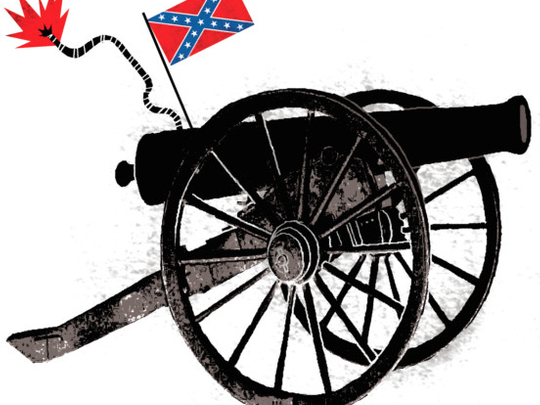
Night had fallen as my wife and I reached the outskirts of Richmond. We’d been driving for several hours, and both of us felt that strange combination of exhilaration and exhaustion that embraces you when you finally arrive at your destination. Our hotel was on the far side of town, so the last tiny leg of our journey involved a drive down Monument Avenue. Stonewall Jackson emerged from the darkness first.
Over 20 feet high, on an oval granite pedestal and his horse standing proudly beneath him, Jackson’s gaze was locked, unmoving, on the horizon. Jefferson Davis came next, at the intersection bearing his name. His plinth was more modest, about 10 feet high. But behind him was a classical colonnade of a dozen Doric pillars, and in front a giant ornate column hosting Vindicatrix, the “Spirit of the South”.
General Lee commandeered the approach to Allen avenue, while Jeb Stuart, sword still in hand, diligently patrolled the corner of Lombardy; the ghosts of the South, mounting their timeless vigil. Over the weekend, in another corner of the old confederacy, Charleston, they were holding a different sort of vigil. It was to remember the victims of the Emanuel church massacre. Candles were lit. Hymns were sung. And across South Carolina, flags flew at half mast. Save for one. In the grounds of the state capitol building, the Confederate battle-flag stood untouched. It might seem trite to be arguing over a flag, given that nine people have just been murdered. But in the United States that is precisely what’s happening.
A ferocious debate has been ignited — it would be more accurate to say reignited — over these faded but highly toxic relics of America’s Civil War. And the morality of clinging to them in 2015. Dylann Roof — who sat with the black parishioners of Emanuel for an hour before he rose to calmly pump bullets into their bodies — certainly clung to them. On Saturday, a photograph emerged of him sitting with his Glock pistol in one hand, the Confederate battle flag in the other. Roof also had a Confederate flag as his car number plate.
Other photos showed him touring Confederate “heritage sites”. In Britain, such a fixation may appear unremarkable. Innocent, even. Our knowledge of Confederate symbolism is primarily gleaned from watching Bo and Luke Duke tearing around the American countryside in the early 1980s, with Sheriff Rosco P. Coltrane in hot pursuit. But to anyone with a passing knowledge of US history, it’s actually staggering there’s a need for a debate about them at all. What are quaintly termed “southern heritage symbols” are seen by most black, and many white, Americans as white power symbols — because that’s precisely what they are.
Perversion
The Confederate flag is no historic abstraction. When it first flew over South Carolina, “Best” black boys between the ages of 10 and 14 were being sold for $500, while “fair to ordinary women” would fetch $1,000. The idea that Stonewall Jackson, General Lee and their comrades were fighting for freedom is a perversion. And, yet, there they are on Monument Avenue. They’re imposing enough in the darkness. But in the warm southern sun, those statues cast an inordinately long shadow. Imagine, for a second, that you are a black boy between the ages of 10 and 14 walking past one on your way to school; or that looking up, you see that flag fluttering in the breeze. I’ve stood up close to those statues, and tried to imagine. And I couldn’t. Many Americans can’t either.
Which is why in 2000, a successful campaign saw the Confederate flag relocated from the dome of the South Carolina state capital to its current location by the Confederate monument. At the time, it was seen as a clever compromise. It seems less clever today. There are some who argue that symbols of this kind can actually help defuse community tension. That by acknowledging the South’s heritage, they provide a bridge between the past and future. But precisely how wide is that bridge supposed to be? It’s now over 150 years since George Pickett’s charge at Gettysburg faltered. How many more times is the South planning on restaging it? More important than that, why does the South feel the need to keep restaging it? The defenders of the flag and these other symbols argue their opponents are seeking to remove them on grounds of pure spite. To “teach the South another lesson”.
Well, the South does indeed need to be taught a lesson. A history lesson. The civil war is over. And the Confederacy lost. Black men and women no longer stand in chains in the cotton fields. They are sitting in the White House. And when you gaze up at these Southern statues and flags, it quickly becomes apparent where the problem lies. They are not a part of the South’s history, but a distortion of the South’s history. Because they maintain the pretence the South won.
Or worse, the pretence the South could still win. If only, as Dylann Roof wrote in his self-styled “manifesto”, someone possessed “the bravery to take it to the real world”. The time has come for the South to lower its flags. And to release its ghosts from their lonely vigil. Perhaps then the guns of the American civil war will finally fall silent.
— The Telegraph Group Limited, London, 2015










